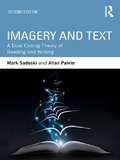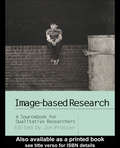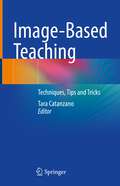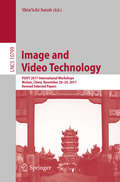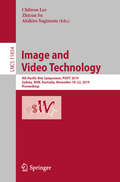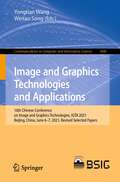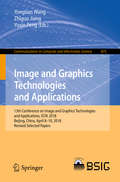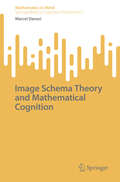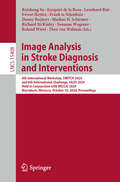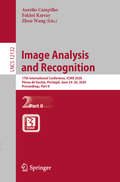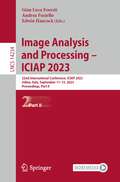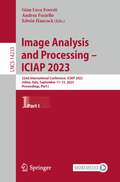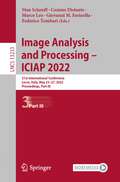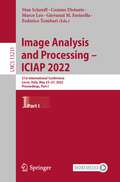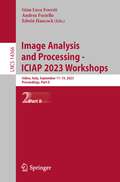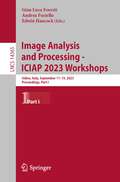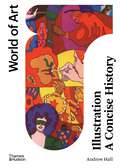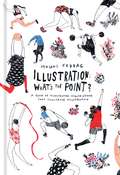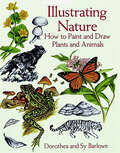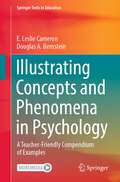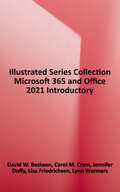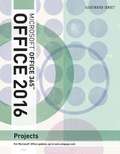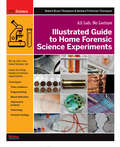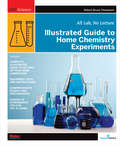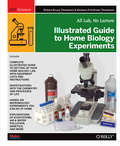- Table View
- List View
Imagery and Text: A Dual Coding Theory of Reading and Writing
by Allan Paivio Mark SadoskiImagery and Text, Second Edition extends the first edition’s unified theory of cognition in literacy from the perspective of Dual Coding Theory (DCT), one of the most influential and empirically sound theories of cognition ever developed. This theory provides a comprehensive, systematic account of all major aspects of literacy including decoding, comprehension, and response in reading and composing in writing. The Second Edition updates DCT as a scientific theory, a cognitive theory, an embodied theory, and a constructivist theory of literacy. New content includes a detailed account of the decoding process and its integral connection to comprehension, a new program of research on DCT in composing text, a review of neuroscientific support, and increased attention to multimedia literacy, socio-cultural influences, and recent educational applications. More than any other theory, DCT explains how both verbal and nonverbal cognition are woven together through all aspects of literacy. Written in concise chapters with illustrative examples, Imagery and Text is approachable for both students and advanced scholars in the field of literacy.
Image-based Research: A Sourcebook for Qualitative Researchers
by Jon ProsserJust what is a picture worth? Qualitative research is dominated by language. However, researchers have recently shown a growing interest in adopting an image-based approach. This is the first volume dedicated to exploring this approach and will prove an invaluable sourcebook for researchers in the field. The book covers a broad scope, including theory and the research process; and provides practical examples of how image-based research is applied in the field. It discusses use of images in child abuse investigation; exploring children's drawings in health education; cartoons; the media and teachers.
Image-Based Teaching: Techniques, Tips and Tricks
by Tara CatanzanoThis book offers detailed information on a variety of teaching techniques for radiology. Generational differences in communication and adult learning theory have led to changes in educational content delivery. Traditional didactic teaching methods are no longer embraced by students, requiring educators to learn and adopt new techniques. Radiologists currently in practice have little or no experience with these newer techniques, some thrust upon them abruptly by the COVID pandemic. In addition to practicing radiologists, the next generation of educators are currently in training and often do not receive instruction on educational theory and teaching techniques. It is incumbent upon members of the educational sphere to provide resources for these individuals. This work intends to provide just such a resource.The objectives of the book include: Explaining adult learning theory and brain-friendly teachingDescribing teaching techniques to leverage brain-friendly teachingReinforcing key points with links to online video-based lectures as an accompaniment to the text Topics covered across chapters include helping non-teaching faculty to teach, writing high quality MCQ questions, and teaching quality, safety, and professionalism. Each chapter will have one “key takeaway” chart at the conclusion of the chapter with high-yield key points highlighted in a bulleted format.This is an ideal guide for practicing radiologists, including those not currently working in academic centers. Faculty in non-academic centers can specifically benefit from chapters related to medical student, clinician and patient education. Future academic radiologists (i.e., fellows and residents) can benefit from the text as a foundation for careers in teaching hospitals and academic medical centers.
Image and Video Technology: PSIVT 2017 International Workshops, Wuhan, China, November 20-24, 2017, Revised Selected Papers (Lecture Notes in Computer Science #10799)
by Shin'Ichi SatohThis book constitutes the thoroughly refereed post-conference proceedings of five international workshops held in the framework of the 8th Pacific-Rim Symposium on Image and Video Technology, PSIVT 2017, in Wuhan, China, in November 2017: Workshop on Human Behavior Analysis; Workshop on Educational Cloud and Image/Video Enriched Cloud Services, ECIVECS; Workshop: Vision Meets Graphics, VG; Workshop on Active Electro-Optical Sensors for Aerial and Space Imaging, EO4AS; and Workshop on Computer Vision and Modern Vehicles, CVMV.The 34 revised full papers and 2 posters presented were carefully selected from 103 submissions. The papers cover the full range of state-of-the-art research in image and video technology with topics ranging from well-established areas to novel current trends.
Image and Video Technology: 9th Pacific-Rim Symposium, PSIVT 2019, Sydney, NSW, Australia, November 18–22, 2019, Proceedings (Lecture Notes in Computer Science #11854)
by Zhixun Su Akihiro Sugimoto Chilwoo LeeThis book constitutes the conference proceedings of the 9th Pacific Rim Symposium on Image and Video Technology, PSIVT 2019, held in Sydney, NSW, Australia, in November 2019. A total of 31 papers were carefully reviewed and selected from 55 submissions. The main conference comprises 11 major subject areas that span the field of image and video technology, namely imaging and graphics hardware and visualization, image/video coding and transmission, image/video processing and analysis, image/video retrieval and scene understanding, applications of image and video technology, biomedical image processing and analysis, biometrics and image forensics, computational photography and arts, computer and robot vision, pattern recognition, and video surveillance.
Image and Graphics Technologies and Applications: 16th Chinese Conference on Image and Graphics Technologies, IGTA 2021, Beijing, China, June 6–7, 2021, Revised Selected Papers (Communications in Computer and Information Science #1480)
by Yongtian Wang Weitao SongThis book constitutes the refereed proceedings of the 16th Conference on Image and Graphics Technologies and Applications, IGTA 2021, held in Beijing, China in June, 2021. The 21 papers presented were carefully reviewed and selected from 86 submissions. They provide a forum for sharing progresses in the areas of image processing technology; image analysis and understanding; computer vision and pattern recognition; big data mining, computer graphics and VR, as well as image technology applications. The volume contains the following thematic blocks: image processing and enhancement techniques (image information acquisition, image/video coding, image/video transmission, image/video storage, compression, completion, dehazing, reconstruction and display, etc.); biometric identification techniques (biometric identification and authentication techniques including face, fingerprint, iris and palm-print, etc.); machine vision and 3D reconstruction (visual information acquisition, camera calibration, stereo vision, 3D reconstruction, and applications of machine vision in industrial inspection, etc.); image/video big data analysis and understanding (object detection and recognition, image/video retrieval, image segmentation, matching, analysis and understanding); computer graphics (modeling, rendering, algorithm simplification and acceleration techniques, realistic scene generation, 3D reconstruction algorithm, system and application, etc.); virtual reality and human-computer interaction (virtual scene generation techniques, tracing and positioning techniques for large-scale space, augmented reality techniques, human-computer interaction techniques based on computer vision, etc.); applications of image and graphics (image/video processing and transmission, biomedical engineering applications, information security, digital watermarking, text processing and transmission, remote sensing, telemetering, etc.); other research works and surveys related to the applications of image and graphics technology.
Image and Graphics Technologies and Applications: 13th Conference On Image And Graphics Technologies And Applications, Igta 2018, Beijing, China, April 8-10, 2018, Revised Selected Papers (Communications In Computer And Information Science #875)
by Yongtian Wang Zhiguo Jiang Yuxin PengThis book constitutes the refereed proceedings of the 13th Chinese Conference on Image and Graphics Technologies and Applications, IGTA 2018, held in Beijing, China in April, 2018. The 64 papers presented were carefully reviewed and selected from 138 submissions. They provide a forum for sharing progresses in the areas of image processing technology; image analysis and understanding; computer vision and pattern recognition; big data mining, computer graphics and VR; as well as image technology applications.
Image Schema Theory and Mathematical Cognition (Mathematics in Mind)
by Marcel DanesiThis book uses blending theory in math cognition, and assesses the main aspect of this theory, called image schema theory. Applied work in math pedagogy has used this theory, but no work has assessed its validity. This book provides an overall assessment of the theory with regard to its validity in the study of math cognition. Overall, this book presents image schema theory as it has evolved today to mathematicians, cognitive scientists, and math educators, deriving from it any concrete implications for modeling math in computer science and, on the other side, for making math pedagogy more effective.
Image Analysis in Stroke Diagnosis and Interventions: 4th International Workshop, SWITCH 2024, and 6th International Challenge, ISLES 2024, Held in Conjunction with MICCAI 2024, Marrakesh, Morocco, October 10, 2024, Proceedings (Lecture Notes in Computer Science #15408)
by Theo van Walsum Roland Wiest Markus D. Schirmer Ruisheng Su Ezequiel de la Rosa Leonhard Rist Ewout Heylen Frank Te Nijenhuis Danny Ruijters Richard McKinley Susanne WegenerThis book constitutes the refereed proceedings of the 4th International MICCAI Stroke Workshop on Imaging and Treatment Challenges, SWITCH 2024, as well as the Ischemic Stroke Lesion Segmentation Challenge, ISLES 2024, held in conjunction with MICCAI 2024, in Marrakesh, Morocco, on October 10, 2024. The 12 revised full papers presented in this volume were selected form 16 submissions. The papers describe research advancements in image analysis for the diagnosis and intervention of ischemic and haemorrhagic stroke and present the latest developments in segmentation, disease prognosis, stroke diagnosis and treatment, and other clinically relevant applications.
Image Analysis and Recognition: 17th International Conference, ICIAR 2020, Póvoa de Varzim, Portugal, June 24–26, 2020, Proceedings, Part II (Lecture Notes in Computer Science #12132)
by Zhou Wang Aurélio Campilho Fakhri KarrayThis two-volume set LNCS 12131 and LNCS 12132 constitutes the refereed proceedings of the 17th International Conference on Image Analysis and Recognition, ICIAR 2020, held in Póvoa de Varzim, Portugal, in June 2020.The 54 full papers presented together with 15 short papers were carefully reviewed and selected from 123 submissions. The papers are organized in the following topical sections: image processing and analysis; video analysis; computer vision; 3D computer vision; machine learning; medical image and analysis; analysis of histopathology images; diagnosis and screening of ophthalmic diseases; and grand challenge on automatic lung cancer patient management.Due to the corona pandemic, ICIAR 2020 was held virtually only.
Image Analysis and Processing – ICIAP 2023: 22nd International Conference, ICIAP 2023, Udine, Italy, September 11–15, 2023, Proceedings, Part II (Lecture Notes in Computer Science #14234)
by Edwin Hancock Andrea Fusiello Gian Luca ForestiThis two-volume set LNCS 14233-14234 constitutes the refereed proceedings of the 22nd International Conference on Image Analysis and Processing, ICIAP 2023, held in Udine, Italy, during September 11–15, 2023.The 85 full papers presented together with 7 short papers were carefully reviewed and selected from 144 submissions. The conference focuses on video analysis and understanding; pattern recognition and machine learning; deep learning; multi-view geometry and 3D computer vision; image analysis, detection and recognition; multimedia; biomedical and assistive technology; digital forensics and biometrics; image processing for cultural heritage; and robot vision.
Image Analysis and Processing – ICIAP 2023: 22nd International Conference, ICIAP 2023, Udine, Italy, September 11–15, 2023, Proceedings, Part I (Lecture Notes in Computer Science #14233)
by Edwin Hancock Andrea Fusiello Gian Luca ForestiThis two-volume set LNCS 14233-14234 constitutes the refereed proceedings of the 22nd International Conference on Image Analysis and Processing, ICIAP 2023, held in Udine, Italy, during September 11–15, 2023.The 85 full papers presented together with 7 short papers were carefully reviewed and selected from 144 submissions. The conference focuses on video analysis and understanding; pattern recognition and machine learning; deep learning; multi-view geometry and 3D computer vision; image analysis, detection and recognition; multimedia; biomedical and assistive technology; digital forensics and biometrics; image processing for cultural heritage; and robot vision.
Image Analysis and Processing – ICIAP 2022: 21st International Conference, Lecce, Italy, May 23–27, 2022, Proceedings, Part III (Lecture Notes in Computer Science #13233)
by Cosimo Distante Marco Leo Stan Sclaroff Giovanni M. Farinella Federico TombariThe proceedings set LNCS 13231, 13232, and 13233 constitutes the refereed proceedings of the 21st International Conference on Image Analysis and Processing, ICIAP 2022, which was held during May 23-27, 2022, in Lecce, Italy,The 168 papers included in the proceedings were carefully reviewed and selected from 307 submissions. They deal with video analysis and understanding; pattern recognition and machine learning; deep learning; multi-view geometry and 3D computer vision; image analysis, detection and recognition; multimedia; biomedical and assistive technology; digital forensics and biometrics; image processing for cultural heritage; robot vision; etc.
Image Analysis and Processing – ICIAP 2022: 21st International Conference, Lecce, Italy, May 23–27, 2022, Proceedings, Part I (Lecture Notes in Computer Science #13231)
by Cosimo Distante Marco Leo Stan Sclaroff Giovanni M. Farinella Federico TombariThe proceedings set LNCS 13231, 13232, and 13233 constitutes the refereed proceedings of the 21st International Conference on Image Analysis and Processing, ICIAP 2022, which was held during May 23-27, 2022, in Lecce, Italy,The 168 papers included in the proceedings were carefully reviewed and selected from 307 submissions. They deal with video analysis and understanding; pattern recognition and machine learning; deep learning; multi-view geometry and 3D computer vision; image analysis, detection and recognition; multimedia; biomedical and assistive technology; digital forensics and biometrics; image processing for cultural heritage; robot vision; etc.
Image Analysis and Processing - ICIAP 2023 Workshops: Udine, Italy, September 11–15, 2023, Proceedings, Part II (Lecture Notes in Computer Science #14366)
by Edwin Hancock Andrea Fusiello Gian Luca ForestiThe two-volume set LNCS 14365 and 14366 constitutes the papers of workshops hosted by the 22nd International Conference on Image Analysis and Processing, ICIAP 2023, held in Udine, Italy, in September 2023.In total, 72 workshop papers and 10 industrial poster session papers have been accepted for publication. Part II of the set, volume 14366, contains 41 papers from the following workshops:– Medical Imaging Hub:• Artificial Intelligence and Radiomics in Computer-Aided Diagnosis (AIR-CAD)• Multi-Modal Medical Imaging Processing (M3IP)• Federated Learning in Medical Imaging and Vision (FedMed)– Digital Humanities Hub:• Artificial Intelligence for Digital Humanities (AI4DH)• Fine Art Pattern Extraction and Recognition (FAPER)• Pattern Recognition for Cultural Heritage (PatReCH)• Visual Processing of Digital Manuscripts: Workflows, Pipelines, BestPractices (ViDiScript)
Image Analysis and Processing - ICIAP 2023 Workshops: Udine, Italy, September 11–15, 2023, Proceedings, Part I (Lecture Notes in Computer Science #14365)
by Edwin Hancock Andrea Fusiello Gian Luca ForestiThe two-volume set LNCS 14365 and 14366 constitutes the papers of workshops hosted by the 22nd International Conference on Image Analysis and Processing, ICIAP 2023, held in Udine, Italy, in September 2023.In total, 72 workshop papers and 10 industrial poster session papers have been accepted for publication. Part I of the set, volume 14365, contains 10 papers from the industrial poster session, and 31 papers from the following workshops:– Advances in Gaze Analysis, Visual attention and Eye-gaze modelling (AGAVE)– Beyond Vision: Physics meets AI (BVPAI)– Automatic Affect Analysis and Synthesis (3AS)– International Contest on Fire Detection (ONFIRE)– Recent Advances in Digital Security: Biometrics and Forensics (BioFor)– Computer Vision for Environment Monitoring and Preservation (CVEMP)– Generation of Human Face and Body Behavior (GHB)
Illustration: A Concise History (World of Art)
by Andrew HallAn indispensable guide to the international history of illustrated images, from 1750 to the present day. Illustration: A Concise History is a dynamic visual journey through the landscape of illustration that maps the evolution of the discipline from the industrial revolution to the postdigital age and showcases over 180 of its most iconic practitioners, including Laura Knight, Antonio Lopez, Käthe Kollwitz, and Hayao Miyazaki. By contextualizing the subject within a framework of key political events, cultural innovations, and technological advances, Andrew Hall redefines how we might think about illustration and the place that it has in our ever-evolving global network. The second half of this introductory volume follows on from the ten chapters charting the chronology of illustration to provide a more in-depth look at its specific commercial genres across eleven feature sections, each including minihistories, practical career advice, and biographies of inspirational practitioners who operated within the field.
Illustration: A Book of Illustrated Illustrations that Illustrate Illustration
by Mouni FeddagOf all the graphic arts, illustration is currently the most dynamic and exciting. In every medium - advertising, book publishing, product design, houseware and home furnishings - new talents are emerging, making their mark and (in some cases) a fortune out of their illustration skills.But why? In this uniquely presented book, gifted illustrator Mouni Feddag takes on the subject and gives it the treatment it deserves. Witty, dynamic, wide-ranging and visual, this title answers the big questions that illustration throws up, including: What's the point of hand-drawn things?What's the point of pictures?What's the point of looking good?What's the point of decoration?What's the point of commercial art?What's the point of repetition?
Illustrating Nature: How to Paint and Draw Plants and Animals (Dover Art Instruction)
by Sy Barlowe Dorothea BarloweThe thrill of recapturing scenes from nature can translate into a rewarding career or an invigorating pastime. Both professionals and hobbyists will benefit from this expert, step-by-step guide, which shows how to draw every aspect of nature, from lush swampland vegetation to shy forest dwellers and even prehistoric creatures. You'll find expert discussions of a variety of media -- pencil, watercolors, oils, acrylics, scratch board, and pen-and-ink -- along with practical advice on how to choose the best method of portraying a particular subject, especially for book or magazine illustration. The authors also consider the difficulties of combining artistic effect with scientific accuracy in rendering color, texture, and form. Helpful individual demonstration projects carefully guide the reader toward mastery of specific techniques. Enhanced with over 400 illustrations and a wealth of tips and suggestions for improving style and presentation, this book is a rich and engaging resource for amateurs and professionals alike.
Illustrating Concepts and Phenomena in Psychology: A Teacher-Friendly Compendium of Examples (Springer Texts in Education)
by Douglas A. Bernstein E. Leslie CameronThis compendium of examples of psychological concepts and phenomena is designed to make it easier for both novice and experienced teachers of psychology at all levels to bring new and/or particularly illuminating examples to their lectures and other presentations.Psychology instructors know that vivid examples bring concepts to life for students, making psychology both more accessible and interesting. Having a good supply of such examples can be particularly important when, as often happens, students fail to immediately grasp particular points, especially those that are complex or difficult. Generating compelling examples can be challenging, particularly when teaching a course, such as Introductory Psychology, in which much of the material is outside one’s main area of expertise, when teaching a course for the first time, or when teaching a course that is entirely outside one’s main area of expertise.This compendium will serve as a one-stop reference that presents a topic-organized body of compelling examples that instructors can explore as they prepare their teaching materials. The examples they will find range from simple illustrations (e.g., muting an obnoxious commercial as an example of negative reinforcement), to videos (e.g., of a patient with prosopagnosia), to brief stories (e.g., about how confirmation bias led a man to dismantle a kitchen because he assumed that an electrical stove’s whining clock was a trapped kitten), to short summaries of research that illustrate a concept or phenomenon.Beyond their value for enhancing the quality and interest level of classroom lectures, the examples in this book can help teachers find ideas for engaging multiple-choice exam and quiz items. They can also serve as stimuli for writing assignments and small group discussions in which students are asked to come up with additional examples of the concept or phenomenon, or link them to other concepts or phenomena.
Illustrated Series Collection, Microsoft 365 & Office 2021 Introductory (MindTap Course List)
by Jennifer Duffy Lisa Friedrichsen Lynn Wermers Carol M. Cram David W. BeskeenIncluding the latest Microsoft 365 features and enhanced support for Mac users, Cengage's Illustrated Series Collection, Microsoft 365 & Office 2021 Introductory, 1st edition, helps you quickly master the nuances of Microsoft Office. Its concise, student-friendly approach uses a proven two-page layout that allows you to work through an entire task without turning the page. Each module begins with a brief overview of the principles covered while large, full-color screen images illustrate what you see on your computer. Module Learning Objectives are mapped to Microsoft Office Specialist (MOS) certification objectives, and module scenarios are based on Burning Glass market insights data -- helping you sharpen the critical skills you need for real-world success. In addition, MindTap and SAM (Skills Assessment Manager) online resources help maximize your study time -- and results.
Illustrated Microsoft® Office 365™ & Office 2016 Projects
by Carol M. CramThis highly visual book offers a wide array of interesting and challenging projects designed to apply the skills learned in any Office 2016 book. The Illustrated Projects book is for people who want more opportunities to practice important software skills.
Illustrated Guide to Home Forensic Science Experiments: All Lab, No Lecture
by Robert Bruce Thompson Barbara Fritchman ThompsonHave you ever wondered whether the forensic science you’ve seen on TV is anything like the real thing? There’s no better way to find out than to roll up your sleeves and do it yourself. This full-color book offers advice for setting up an inexpensive home lab, and includes more than 50 hands-on lab sessions that deal with forensic science experiments in biology, chemistry, and physics. You’ll learn the practical skills and fundamental knowledge needed to pursue forensics as a lifelong hobby—or even a career.The forensic science procedures in this book are not merely educational, they’re the real deal. Each chapter includes one or more lab sessions devoted to a particular topic. You’ll find a complete list of equipment and chemicals you need for each session.Analyze soil, hair, and fibersMatch glass and plastic specimensDevelop latent fingerprints and reveal blood tracesConduct drug and toxicology testsAnalyze gunshot and explosives residuesDetect forgeries and fakesAnalyze impressions, such as tool marks and footprintsMatch pollen and diatom samplesExtract, isolate, and visualize DNA samplesThrough their company, The Home Scientist, LLC (thehomescientist.com/forensics), the authors also offer inexpensive custom kits that provide specialized equipment and supplies you’ll need to complete the experiments. Add a microscope and some common household items and you’re good to go.
Illustrated Guide to Home Chemistry Experiments: All Lab, No Lecture
by Robert Bruce ThompsonFor students, DIY hobbyists, and science buffs, who can no longer get real chemistry sets, this one-of-a-kind guide explains how to set up and use a home chemistry lab, with step-by-step instructions for conducting experiments in basic chemistry -- not just to make pretty colors and stinky smells, but to learn how to do real lab work:Purify alcohol by distillationProduce hydrogen and oxygen gas by electrolysisSmelt metallic copper from copper ore you make yourselfAnalyze the makeup of seawater, bone, and other common substancesSynthesize oil of wintergreen from aspirin and rayon fiber from paperPerform forensics tests for fingerprints, blood, drugs, and poisonsand much moreFrom the 1930s through the 1970s, chemistry sets were among the most popular Christmas gifts, selling in the millions. But two decades ago, real chemistry sets began to disappear as manufacturers and retailers became concerned about liability. ,em>The Illustrated Guide to Home Chemistry Experiments steps up to the plate with lessons on how to equip your home chemistry lab, master laboratory skills, and work safely in your lab. The bulk of this book consists of 17 hands-on chapters that include multiple laboratory sessions on the following topics:Separating MixturesSolubility and SolutionsColligative Properties of SolutionsIntroduction to Chemical Reactions & StoichiometryReduction-Oxidation (Redox) ReactionsAcid-Base ChemistryChemical KineticsChemical Equilibrium and Le Chatelier's PrincipleGas ChemistryThermochemistry and CalorimetryElectrochemistryPhotochemistryColloids and SuspensionsQualitative AnalysisQuantitative AnalysisSynthesis of Useful CompoundsForensic ChemistryWith plenty of full-color illustrations and photos, Illustrated Guide to Home Chemistry Experiments offers introductory level sessions suitable for a middle school or first-year high school chemistry laboratory course, and more advanced sessions suitable for students who intend to take the College Board Advanced Placement (AP) Chemistry exam. A student who completes all of the laboratories in this book will have done the equivalent of two full years of high school chemistry lab work or a first-year college general chemistry laboratory course.This hands-on introduction to real chemistry -- using real equipment, real chemicals, and real quantitative experiments -- is ideal for the many thousands of young people and adults who want to experience the magic of chemistry.
Illustrated Guide to Home Biology Experiments: All Lab, No Lecture
by Robert Bruce Thompson Barbara Fritchman ThompsonExperience the magic of biology in your own home lab. This hands-on introduction includes more than 30 educational (and fun) experiments that help you explore this fascinating field on your own. Perfect for middle- and high-school students and DIY enthusiasts, this full-color guide teaches you the basics of biology lab work and shows you how to set up a safe lab at home.The Illustrated Guide to Home Biology Experiments is also written with the needs of homeschoolers firmly in mind, as well as adults who are eager to explore the science of nature as a life-long hobby. To get the most from the experiments, we recommend using this guide in conjunction with a standard biology text, such as the freely downloadable CK-12 Biology (ck-12.org).Master the use of the microscope, including sectioning and stainingBuild and observe microcosms, soda-bottle worlds of pond lifeInvestigate the chemistry of life from simple acids, bases, and buffers to complex carbohydrates, proteins, lipids, enzymes, and DNAExtract, isolate, and observe DNAExplore photosynthesis, osmosis, nitrogen fixation, and other life processesInvestigate the cell cycle (mitosis and cytokinesis)Observe populations and ecosystems, and perform air and water pollution testsInvestigate genetics and inheritanceDo hands-on microbiology, from simple culturing to micro-evolution of bacteria by forced selectionGain hands-on lab experience to prepare for the AP Biology examThrough their company, The Home Scientist, LLC (thehomescientist.com/biology), the authors also offer inexpensive custom kits that provide specialized equipment and supplies you’ll need to complete the experiments. Add a microscope and some common household items and you’re good to go.
